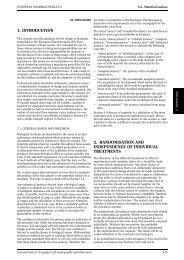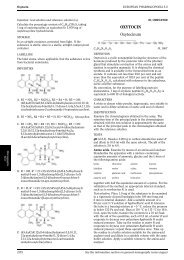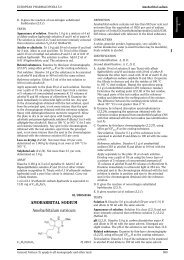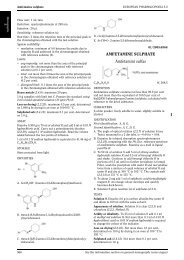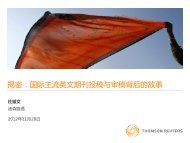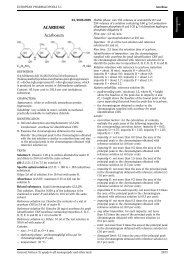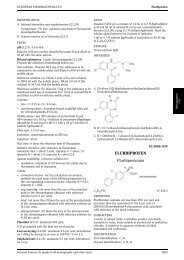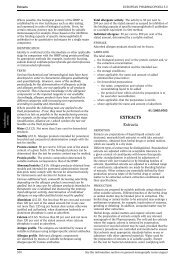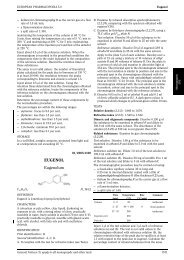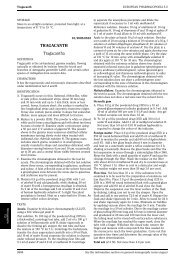CASCARA Rhamni purshianae cortex
CASCARA Rhamni purshianae cortex
CASCARA Rhamni purshianae cortex
You also want an ePaper? Increase the reach of your titles
YUMPU automatically turns print PDFs into web optimized ePapers that Google loves.
Cascara EUROPEAN PHARMACOPOEIA 5.0<br />
— stationary phase: octylsilyl silica gel for<br />
chromatography R (5 µm),<br />
— temperature: 55°C.<br />
Mobile phase: dissolve 1.77 g of potassium dihydrogen<br />
phosphate R in water R anddiluteto650mlwiththesame<br />
solvent; adjust to pH 2.0 with phosphoric acid R and add<br />
350 ml of acetonitrile R.<br />
Flow rate: 1.0ml/min.<br />
Detection: spectrophotometer at 240 nm.<br />
Injection: 20µl.<br />
Run time: 8 times the retention time of carvedilol.<br />
Relative retention with reference to carvedilol<br />
(retention time = about 4 min): impurity A = about 0.6;<br />
impurity C = about 3.5; impurity B = about 6.7.<br />
System suitability: reference solution (b):<br />
— resolution: minimum 17 between the peaks due to<br />
carvedilol and to impurity C.<br />
Limits:<br />
— correction factor: for the calculation of content, multiply<br />
the peak area of impurity A by 2,<br />
— impurity A: not more than twice the area of the principal<br />
peak in the chromatogram obtained with reference<br />
solution (a) (0.2 per cent),<br />
— impurity C: not more than twice the area of the<br />
corresponding peak in the chromatogram obtained with<br />
reference solution (c) (0.02 per cent),<br />
— any other impurity: not more than the area of the<br />
principal peak in the chromatogram obtained with<br />
reference solution (a) (0.1 per cent),<br />
— total: not more than 5 times the area of the principal peak<br />
in the chromatogram obtained with reference solution (a)<br />
(0.5 per cent),<br />
— disregard limit: the area of the principal peak in the<br />
chromatogram obtained with reference solution (c)<br />
(0.01 per cent).<br />
Heavy metals (2.4.8): maximum 10 ppm.<br />
2.0gcomplieswithlimittestC.Preparethestandardusing<br />
2.0 ml of lead standard solution (10 ppm Pb) R.<br />
Loss on drying (2.2.32): maximum 0.5 per cent, determined<br />
on 1.000 g by drying in an oven at 100-105 °C.<br />
Sulphated ash (2.4.14): maximum 0.1 per cent, determined<br />
on 1.0 g.<br />
ASSAY<br />
Dissolve 0.350 g in 60 ml of anhydrous acetic acid R.Titrate<br />
with 0.1 M perchloric acid, determining the end-point<br />
potentiometrically (2.2.20).<br />
1mlof0.1 M perchloric acid is equivalent to 40.65 mg of<br />
C24H26N2O4. IMPURITIES<br />
A. 1-[[9-[2-hydroxy-3-[[2-(2-methoxyphenoxy)ethyl]amino]propyl]-9H-carbazol-4-yl]oxy]-3-[[2-(2-methoxyphenoxy)ethyl]amino]propan-2-ol,<br />
B. 1,1′-[[2-(2-methoxyphenoxy)ethyl]nitrilo]bis[3-(9Hcarbazol-4-yloxy)propan-2-ol],<br />
C. (2RS)-1-[benzyl[2-(2-methoxyphenoxy)ethyl]amino]-3-(9Hcarbazol-4-yloxy)propan-2-ol.<br />
<strong>CASCARA</strong><br />
<strong>Rhamni</strong> <strong>purshianae</strong> <strong>cortex</strong><br />
01/2005:0105<br />
DEFINITION<br />
Cascara consists of the dried, whole or fragmented bark<br />
of Rhamnus purshianus D.C. (Frangula purshiana (D.C.)<br />
A. Gray ex J. C. Cooper). It contains not less than 8.0 per<br />
cent of hydroxyanthracene glycosides of which not less<br />
than 60 per cent consists of cascarosides, both expressed<br />
as cascaroside A (C27H32O14; Mr 580.5) and calculated with<br />
reference to the dried drug.<br />
CHARACTERS<br />
It has the macroscopic and microscopic characters described<br />
under identification tests A and B.<br />
IDENTIFICATION<br />
A. The bark occurs in slightly channelled or nearly flat<br />
pieces, usually 1 mm to 5 mm in thickness, usually<br />
varying greatly in length and width. The outer surface is<br />
grey or dark greyish-brown and shows occasional lenticels<br />
that are orientated transversally. It is usually more or less<br />
completely covered by a whitish coat of lichens, epiphytic<br />
moss and foliaceous liverwort. The inner surface is yellow<br />
to reddish-brown or almost black with fine longitudinal<br />
striations; it turns red when treated with alkali. The<br />
yellow fracture is short and granular in the outer part and<br />
somewhat fibrous at the inner part.<br />
B. Reduce to a powder (355). The powder is yellowish-brown.<br />
Examineunderamicroscopeusingchloral hydrate<br />
solution R. Thepowdershows:bundlesofpartly<br />
lignified phloem fibres accompanied by crystal sheaths<br />
containing prisms of calcium oxalate; groups of sclereids<br />
accompanied by crystal sheaths; cluster crystals of<br />
calcium oxalate; some parenchymatous cells contain a<br />
yellow substance which becomes deep red when treated<br />
with alkali; cork cells and, frequently, epiphytes; the<br />
latter may be liverworts, entire or in fragments, having a<br />
1194 See the information section on general monographs (cover pages)
EUROPEAN PHARMACOPOEIA 5.0 Cascara<br />
lamina one cell thick without a midrib and composed of<br />
isodiametric cells, or leaves of mosses, having a lamina<br />
one cell thick composed of elongated cells and possessing<br />
a midrib several cells thick.<br />
C. Examine the chromatograms obtained in the test for<br />
“Other species of Rhamnus; anthrones” after spraying<br />
with a 50 g/l solution of potassium hydroxide R<br />
in alcohol (50 per cent V/V) R and heating. The<br />
chromatogram obtained with the test solution shows<br />
several reddish-brown zones with different intensities:<br />
there are four faint zones, three being situated at about<br />
the mid-point of the chromatogram and one in the lower<br />
third and there is a strong zone in the upper third of the<br />
chromatogram. Examine in ultraviolet light at 365 nm.<br />
The chromatogram obtained with the test solution shows<br />
several zones with the same fluorescence, situated above<br />
and particularly below (cascarosides) that corresponding<br />
tobarbaloininthechromatogramobtainedwiththe<br />
reference solution.<br />
D. Heat 0.2 g of the powdered drug (180) with 50 ml of<br />
water R on a water-bath for 15 min. Allow to cool and<br />
filter. To 10 ml of the filtrate add 20 ml of hydrochloric<br />
acid R1 and heat on a water-bath for 15 min. Allow to<br />
cool, transfer to a separating funnel and shake with three<br />
quantities, each of 20 ml, of ether R. Reserve the aqueous<br />
layer (solution A).<br />
(a) Combine the three ether extracts and shake with<br />
10 ml of dilute ammonia R2. Theaqueouslayerbecomes<br />
reddish-violet.<br />
(b) Transfer solution A to a small flask, add 5 g of ferric<br />
chloride R and heat on a water-bath for 30 min. Allow<br />
to cool, transfer to a separating funnel and shake with<br />
15 ml of ether R. Wash the ether layer with 10 ml of<br />
water R, discard the water and shake the ether layer with<br />
5mlofdilute ammonia R2. A red colour develops in the<br />
aqueous layer.<br />
solution of nitrotetrazolium blue R in methanol R. Examine<br />
the chromatogram immediately. No violet or greyish-blue<br />
zones appear.<br />
Foreign matter (2.8.2). Not more than 1 per cent.<br />
Loss on drying (2.2.32). Not more than 10.0 per cent,<br />
determined on 1.000 g of the powdered drug (180) by drying<br />
in an oven at 100 °C to 105 °C for 2 h.<br />
Total ash (2.4.16). Not more than 7.0 per cent.<br />
ASSAY<br />
Carry out the assay protected from bright light in one day.<br />
Stir 1.00 g of the powdered drug (180) into 100 ml of<br />
boiling water R and continue boiling and stirring for 5 min.<br />
Allow to cool, dilute to 100.0 ml with water R, shake,filter<br />
and discard the first 20 ml of filtrate. Transfer 10.0 ml<br />
of the filtrate to a separating funnel, add 0.1 ml of 1M<br />
hydrochloric acid and shake with two quantities, each of<br />
20 ml, of a mixture of 1 volume of ether R and 3 volumes of<br />
hexane R. Wash the combined organic extracts with 5 ml of<br />
water R, discard the organic layer and return the rinsings<br />
to the aqueous layer. Shake the combined aqueous layers<br />
with four quantities, each of 30 ml, of ethyl acetate R freshly<br />
saturated with water R, (to150mlofethyl acetate R add<br />
15 ml of water R, shake for 3 min and allow to stand) on<br />
each occasion allowing separation to take place until the<br />
organic layer is clear. Combine the ethyl acetate extracts.<br />
Use the aqueous layer for the assay for cascarosides and the<br />
organic layer for the assay for hydroxyanthracene glycosides<br />
other than cascarosides.<br />
Hydroxyanthracene glycosides other than cascarosides.<br />
Transfer the organic layer to a suitable flask and remove<br />
the solvent by distillation, evaporating almost to dryness.<br />
Dissolve the residue in 0.3 ml to 0.5 ml of methanol R and<br />
transfer to a volumetric flask, rinsing the first flask with<br />
warm water R and adding the rinsings to the methanolic<br />
solution. Allow to cool and dilute to 50.0 ml with water R.<br />
Transfer 20.0 ml of the solution to a 100 ml round-bottomed<br />
flask with a ground-glass neck and containing 2 g of ferric<br />
chloride R and 12 ml of hydrochloric acid R.Attachareflux<br />
condenser and place the flask in a water-bath so that the<br />
level of the water is above that of the liquid in the flask<br />
and heat for 4 h. Allow to cool, transfer the solution to<br />
a separating funnel and rinse the flask successively with<br />
3mlto4mlof1M sodium hydroxide and 3 ml to 4 ml of<br />
water R, adding the rinsings to the separating funnel. Shake<br />
the contents of the separating funnel with three quantities,<br />
each of 30 ml, of a mixture of 1 volume of ether R and<br />
3 volumes of hexane R. Washthecombinedorganiclayers<br />
with two quantities, each of 10 ml, of water R and discard<br />
the rinsings. Dilute the organic phase to 100.0 ml with<br />
the mixture of ether and hexane. Take 20.0 ml, evaporate<br />
carefully to dryness on a water-bath and dissolve the residue<br />
in 10.0 ml of a 5 g/l solution of magnesium acetate R in<br />
methanol R. Measuretheabsorbance(2.2.25) at515nm<br />
using methanol R as the compensation liquid.<br />
Calculate the percentage content of hydroxyanthracene<br />
glycosides, expressed as cascaroside A, from the expression:<br />
TESTS<br />
Other species of Rhamnus; anthrones.Examineby<br />
thin-layer chromatography (2.2.27), using a suitable silica<br />
gel as the coating substance.<br />
Test solution. To 0.5 g of the powdered drug (180) add 5 ml<br />
of alcohol (70 per cent V/V) R and heat to boiling. Cool and<br />
centrifuge. Decant the supernatant solution immediately<br />
and use within 30 min.<br />
Reference solution. Dissolve 20 mg of barbaloin R in<br />
alcohol (70 per cent V/V) R and dilute to 10 ml with the<br />
same solvent.<br />
Apply separately to the plate as bands 10 µl of each solution.<br />
Develop over a path of 10 cm using a mixture of 13 volumes<br />
of water R, 17volumesofmethanol R and 100 volumes of<br />
ethyl acetate R. Allow the plate to dry for 5 min, spray with<br />
about10mlofa50g/lsolutionofpotassium hydroxide R<br />
in alcohol (50 per cent V/V) R and heat at 100 °C to 105 °C<br />
for 15 min. Examine the chromatograms immediately after<br />
heating. The chromatogram obtained with the reference<br />
solution shows, in the central part, a reddish-brown zone<br />
corresponding to barbaloin. Examine in ultraviolet light<br />
at 365 nm. The zone corresponding to barbaloin shows<br />
intense yellowish-brown fluorescence. In the chromatogram i.e.takingthespecificabsorbancetobe180.<br />
obtained with the test solution, no zone with orange-brown<br />
fluorescence is seen between the zone of barbaloin and the<br />
zones of cascarosides.<br />
A<br />
m<br />
=<br />
=<br />
absorbance at 515 nm,<br />
massofthesampleingrams.<br />
Apply to another plate as a band 10 µl of the test solution Measure the absorbance of the test solution at 440 nm. If<br />
and develop as described above. Allow the plate to dry for the ratio of the absorbance at 515 nm to that at 440 nm is<br />
not longer than 5 min and spray immediately with a 5 g/l less than 2.4, the assay is not valid and must be repeated.<br />
GeneralNotices(1)applytoallmonographsandothertexts 1195
Cassia oil EUROPEAN PHARMACOPOEIA 5.0<br />
Cascarosides. Dilute the aqueous layer reserved for this<br />
assay to 50.0 ml with water R. Treat 20.0 ml of the solution<br />
as described above in the assay of hydroxyanthracene<br />
glycosides other than cascarosides.<br />
Measure the absorbance of the test solution at 440 nm. If<br />
theratiooftheabsorbanceat515nmtothatat440nmis<br />
less than 2.4, the assay is not valid and must be repeated.<br />
Calculate the percentage content of cascarosides, expressed<br />
as cascaroside A from the expression:<br />
i.e.takingthespecificabsorbancetobe180.<br />
A = absorbance at 515 nm,<br />
m = massofthesampleingrams.<br />
Measure the absorbance of the test solution at 440 nm. If<br />
theratiooftheabsorbanceat515nmtothatat440nmis<br />
less than 2.7, the assay is not valid and must be repeated.<br />
STORAGE<br />
Store protected from light.<br />
CASSIA OIL<br />
01/2005:1496<br />
Cinnamomi cassiae aetheroleum<br />
DEFINITION<br />
Cassia oil is obtained by steam distillation of the leaves<br />
and young branches of Cinnamomum cassia Blume<br />
(C. aromaticum Nees).<br />
CHARACTERS<br />
A clear, mobile, yellow to reddish-brown liquid, with a<br />
characteristic odour reminiscent of cinnamic aldehyde.<br />
IDENTIFICATION<br />
First identification: B.<br />
Second identification: A.<br />
A. Examine by thin-layer chromatography (2.2.27), using a<br />
TLC silica gel plate R.<br />
Test solution. Dissolve0.5mlofthesubstancetobe<br />
examined in acetone R and dilute to 10 ml with the same<br />
solvent.<br />
Reference solution. Dissolve50µloftrans-cinnamic<br />
aldehyde R,10µlofeugenol R and 50 mg of coumarin R<br />
in acetone R and dilute to 10 ml with the same solvent.<br />
Apply to the plate, as bands, 10 µl of each solution.<br />
Develop over a path of 15 cm using a mixture of<br />
10 volumes of methanol R and 90 volumes of toluene R.<br />
Allow the plate to dry in air and examine in ultraviolet<br />
light at 365 nm. The zone of blue fluorescence in the<br />
chromatogram obtained with the test solution is similar<br />
in position and colour to the zone in the chromatogram<br />
obtained with the reference solution (coumarin). Spray<br />
the plate with anisaldehyde solution R. Examinein<br />
daylight while heating at 100-105 °C for 5-10 min. The<br />
chromatogram obtained with the reference solution<br />
shows in its upper part a violet zone (eugenol) and above<br />
this zone a greenish-blue zone (trans-cinnamic aldehyde).<br />
The chromatogram obtained with the test solution shows<br />
a zone similar in position and colour to the zone due to<br />
trans-cinnamic aldehyde in the chromatogram obtained<br />
with the reference solution and may show a very faint<br />
zone corresponding to eugenol. Other faint zones are<br />
present.<br />
B. Examine the chromatograms obtained in the test for<br />
chromatographic profile. The retention times of the<br />
principal peaks in the chromatogram obtained with the<br />
test solution are similar to those in the chromatogram<br />
obtained with the reference solution. Eugenol may be<br />
absent from the chromatogram obtained with the test<br />
solution.<br />
TESTS<br />
Relative density (2.2.5): 1.052 to 1.070.<br />
Refractive index (2.2.6): 1.600 to 1.614.<br />
Optical rotation (2.2.7): −1° to + 1°.<br />
Chromatographic profile. Examinebygaschromatography<br />
(2.2.28).<br />
Test solution. Thesubstancetobeexamined.<br />
Reference solution. Dissolve100µloftrans-cinnamic<br />
aldehyde R, 10µlofcinnamyl acetate R, 10µl<br />
of eugenol R, 20mgofcoumarin R and 10 µl of<br />
trans-2-methoxycinnamaldehyde R in 1 ml of acetone R.<br />
The chromatographic procedure may be carried out using:<br />
— a fused-silica column 60 m long and about 0.25 mm in<br />
internal diameter coated with macrogol 20 000 R as the<br />
bonded phase,<br />
— helium for chromatography R as the carrier gas at a flow<br />
rate of 1.5 ml/min,<br />
— a flame-ionisation detector,<br />
— a split ratio of 1:100,<br />
with the following temperature programme:<br />
Time<br />
(min)<br />
Temperature<br />
(°C)<br />
Rate<br />
(°C/min)<br />
Comment<br />
Column 0-10 60 – isothermal<br />
10 - 75 60 → 190 2 linear gradient<br />
75 - 160 190 isothermal<br />
Injection port 200<br />
Detector 240<br />
Inject 0.2 µl of the reference solution. When the<br />
chromatogram is recorded in the prescribed conditions, the<br />
components elute in the order indicated in the composition<br />
of the reference solution. Depending on the operating<br />
conditions and the state of the column, coumarin may elute<br />
before or after trans-2-methoxycinnamaldehyde. Record the<br />
retention times of these substances.<br />
Thetestisnotvalidunlesstheresolutionbetween<br />
the peaks corresponding to coumarin and<br />
trans-2-methoxycinnamaldehyde is at least 1.5.<br />
Inject 0.2 µl of the test solution. Using the retention times<br />
determined from the chromatogram obtained with the<br />
reference solution, locate the components of the reference<br />
solution in the chromatogram obtained with the test<br />
solution. Determine the percentage content of each of these<br />
components by the normalisation procedure.<br />
The percentages are within the following ranges:<br />
— trans-cinnamic aldehyde: 70percentto90percent,<br />
— cinnamyl acetate: 1.0 per cent to 6.0 per cent,<br />
— eugenol: lessthan0.5percent,<br />
— coumarin: 1.5 per cent to 4.0 per cent,<br />
— trans-2-methoxycinnamaldehyde: 3.0 per cent to 15 per<br />
cent.<br />
1196 See the information section on general monographs (cover pages)



